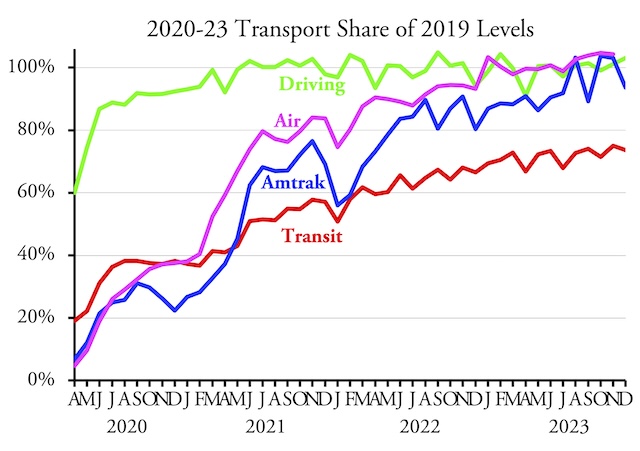Transit carried 73.7 percent as many riders in December 2023 as the same month in 2019, according to data released by the Federal Transit Administration yesterday. As I predicted last month, this was a slight decline from the 74.9 percent reported for November because November had one more business day in 2023 than 2019 while December had one fewer.
Amtrak ridership, as a share of 2019 levels, declined from 103.1 percent in November to 93.6 percent in December according to Amtrak’s monthly performance report released last week. This may suggest that holiday travelers are still wary of taking trains. It also raises questions about why Amtrak numbers have been bouncing up and down so much over the past several months. Air travel has not been so bouncy: according to TSA passenger counts, air travel grew from 101.2 of 2019 levels in November to 103.1 percent in December.
I’ve noted before that monthly FTA reports sometimes are missing data from a few transit agencies but the agency adds them to later reports when they become available. The addition of missing data, for example, nudged November’s number up from the 74.9 percent I reported last month to 75.0 percent. The above chart is based on data updated back to April 2020. WIth these corrections, transit carried 71.7 percent, Amtrak carried 91.7 percent, and the airlines carried 101.5 percent as many riders in calendar year 2023 as in 2019. Highway data will be released soon and I’ll report it here.
Transit in December did particularly well in Los Angeles (80.4%), Miami (82.7%), Houston (84.9%), San Diego (88.1%), and Tampa-St. Petersburg (80.7%). It was also above average in New York (76.5%), which always raises the national average because 45 percent of all transit trips are in the New York urban area. Note that, other than New York and to a lesser extent Los Angeles, none of these are big transit cities.
Transit continues to do poorly in Chicago (62.5%), Philadelphia (61.9%), Atlanta (61.2%), Boston (64.6%), Phoenix (55.6%), the Twin Cities (62.8%), Denver (60.4%), and St. Louis (58.9%). Chicago, Philadelphia, and Boston are historically transit-heavy cities with high numbers of downtown jobs; the others on this list are cities that attempted to attract white-collar workers out of their cars by building expensive rail transit systems. Whether they worked downtown or were attracted by new rail lines, many of those former transit commuters are now working at home while others are enjoying the reduced congestion that comes from more people working remotely.









A guy on Facebook talked about how New York rebound, adaptive re-use will turn those office towers into residential space. This will actually breathe life into Lower Manhattan AND into the subway (as it becomes more efficient due to more bi-directional traffic).”
I laughed.
1: Both people and jobs are moving away from cities, so even if these buildings are converted to residential, whose gonna live in them?
2: the rents for such converted 50-70 story buildings to pay for the general upkeep would be substantial; hence only useful as high income housing; no shortage of which for them.
3: These high rises are not designed for human habitation, converting them will be expensive, probably more than single family homes out of the city.
4: If cities allow such conversion and they do not happen, you know the next step will be that cities will simply subsidize the conversions rather than deal with empty buildings. THus a subsidy racket will emerge
5: Thus, said buildings would have to be demolished for residential ones. More expensive than conversion.
6: To raise/adapt families these building districts need schools, grocery stores, playgrounds, yards, amenity spaces; none which exist in these districts.
7: Few of any of these buildings have typical residential trappings for urban life. No porticos, frontages, no balcony’s no roof gardens, no terraces, no front/rear yards.
What else should one expect from WrongTowns?
So many of the organization’s articles have simply been anti-car and pro transit-dependency. Its articles also often promote density for the sake of density. Density adds more people and buildings (i.e., congestion) between where you are and your destination. Density does not shorten the distance to the destination. There is nothing meritorious about density. There is nothing meritorious about transit dependency as a policy.
… and the above comment about WrongTowns was intended to be a response to the February 6, 2024 article “Do More Subsidies Increase Efficiency?” However there is no way to edit or delete posts!
I read Strong Towns from time to time. For all good intensions.
Behind every walkable community street, is abundant parking.
I’m all for more walking/bike friendly towns. Easier than in big cities…
EV bikes are far more revolutionary than EV cars.
There are 20 million electric cars/vehicles on Roads worldwide, barely 2% global vehicle fleet.
By contrast there are 280 Million Electric assisted bicycles, mopeds, scooters and 3-wheeled vehicles.
WHile EV” certainly are invariably cleaner cars, but they are still cars, thus they do facet taking up space on the roads, being stuck in traffic like their gas powered cousins and requiring a lot of electricity to power them. Their batteries make them heavier than normal cars and are wrecking up the roads because there’s no fuel taxes/tariffs to pay for it’s upkeep and draw heavily on the extraction of critical resources most of it done in third world.